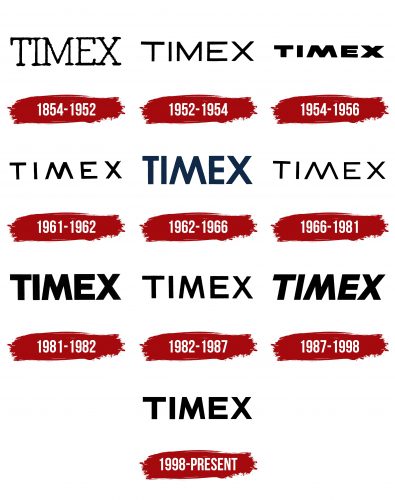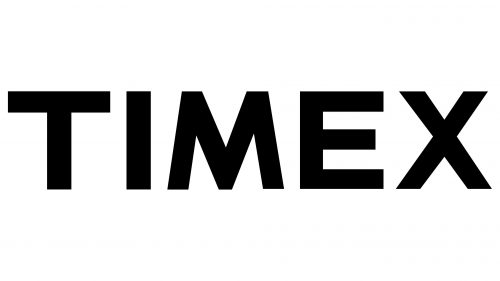The Timex logo embodies durability and timeless classic style. Its clean and straight lines evoke a sense of confidence and stability, reflecting the brand’s core values. The emblem harmoniously combines strength, simplicity, and reliability, highlighting the products’ character and longevity. This minimalist yet powerful symbol accurately conveys the company’s mission – creating high-quality, durable products lasting years.
Timex: Brand overview
Timex’s history began in 1854 in Waterbury, Connecticut, USA, with the founding of the Waterbury Clock Company, the predecessor of the Timex Group. The company initially focused on producing affordable wall clocks using brass components.
In the 1870s, the Waterbury Clock Company began manufacturing pocket watches. By using innovative mass production techniques, the company significantly reduced the cost of its watches, making them accessible to a broader audience.
1887, the company introduced the Yankee pocket watch, which was priced at just $1. These affordable and reliable timepieces helped the brand gain recognition for creating dependable products at reasonable prices.
As the 20th century approached, the business faced new opportunities and challenges. In 1900, the Waterbury Clock Company began producing wristwatches. During World War I, men’s wristwatches became more popular as the company began manufacturing military timepieces in 1914.
In the 1930s, the business collaborated with the Walt Disney Company, releasing the first Mickey Mouse watch in 1933. This model became a huge success, helping the company survive the difficult years of the Great Depression.
In 1941, the company rebranded itself as the United States Time Corporation. During World War II, it manufactured watches and fuses for the military.
The 1950s marked a turning point for the company. In 1950, the Timex brand was born with the introduction of its first model. These watches became widely popular for their durability and affordability.
In 1956, the brand launched its famous advertising campaign, “Takes a licking and keeps on ticking.” The campaign featured rigorous tests to demonstrate the watches’ durability, further cementing the company’s reputation for toughness.
The business experienced rapid growth during the 1960s. By 1962, Timex watches accounted for one-third of all watches sold in the U.S. The company also expanded internationally, establishing production facilities in Asia and Europe.
In the 1970s, the business faced strong competition from quartz watch manufacturers. In response, it developed its quartz technology and released its first digital watch in 1972.
The 1980s brought more innovation. In 1986, the company introduced its signature electroluminescent backlight, Indiglo, which became one of its most recognizable features.
In 1994, the company changed its name to Timex Corporation, reflecting the brand’s strength.
During the 2000s, the business diversified by acquiring other watch brands like Versace, Nautica, and Opex. 2008, Timex Group was established to unify all the company’s brands under one umbrella.
In 2015, the brand launched its first smartwatch, the Timex IQ+, which combined a traditional analog design with fitness-tracking features.
In 2019, the company introduced the American Documents collection, the first line made entirely in the USA in decades.
Responding to consumer demand for retro styles, the business reintroduced several iconic models in 2020, including the Marlin and Q Timex.
As of 2023, the company remains one of the largest watch producers in the world, known for its reliability and affordability. It continues to evolve, focusing on its classic collections and new ventures, such as smartwatches and collaborations with renowned designers and brands.
The company’s story is one of American entrepreneurship and innovation. From its beginnings as a small business producing inexpensive pocket watches to a global brand, the company has consistently aimed to deliver reliable and affordable watches for many customers while continually adapting to market demands and technological advancements.
Meaning and History
What is Timex?
This well-known American watch company has established itself through its products’ affordability, cost-effectiveness, and durability. The brand has become synonymous with everyday watches, offering various models, from modern digital and smartwatches to vintage analog styles. The company skillfully combines innovation and nostalgia, regularly reissuing popular classic models with added modern features. One of the brand’s key achievements is the Indiglo backlight technology, which has improved the visibility of watches in low-light conditions. Partnerships with artists, designers, and other brands allow the company to maintain the relevance and variety of its products.
1854 – 1952
The first Timex logo is a wordmark created with thin craft lines resembling a handwritten style. The capital letters emphasize the brand’s important goal — to offer the market watches that combine high accuracy and durability at an affordable price. This approach became possible because a new alloy replaced expensive precious materials. The narrow and elongated glyphs symbolize the accessibility of the products and the company’s commitment to continuous improvement and development.
1952 – 1954
Two years later, the logo’s sans-serif font became wider and more defined, reflecting the brand’s confidence and strengthened market position. The straight lines of the glyphs emphasize simplicity and accessibility, which aligns with the company’s philosophy and drive for widespread success. The font change symbolized the growth in sales and the company’s increasing influence in the watch industry.
1954 – 1956
The logo acquired broad and massive letters, highlighting the reliability and durability of Timex watches. The small font size hinted at the compactness and convenience of wrist models, which were renowned for their long lifespan. In advertising campaigns, the company showcased durability tests of its products, where the watches withstood challenges and continued to function flawlessly. This focus on endurance was successfully reflected in the emblem’s bold, sturdy lines, conveying the brand’s strength and quality.
1961 – 1962
The logo adopted medium-sized and moderately thick letters, symbolizing elegance and the brand’s continuous renewal. This highlighted the company’s development and adaptation to new technologies when it entered the market with electric watches after the acquisition of Lacher & Co. AG. This transformation marked an important milestone in the brand’s history, and the logo successfully reflected the drive for innovation while maintaining sophistication and style.
1962 – 1966
The company secured its position at the top of the American market, symbolized by large, vertically elongated dark blue letters. The font size represents impressive sales volumes, while the elongated symbols reflect continuous growth. One in every three watches sold in the U.S. is a Timex. The brand is actively expanding, increasing the number of retail locations from small shops to gas stations. With each iteration, the logo reflects this development, its letters growing along with the company’s success. The dark blue color emphasizes the professionalism and stability of the brand.
1966 – 1981
The brand once again turned to a thin font, symbolizing the pursuit of new beginnings and an emphasis on developing and introducing fresh models to the market. This move reflects the search for innovative solutions and the desire to maintain growth momentum. The company that owns the brand also changed its name to Timex Corporation, which demonstrates a focus on the most successful and promising line of the brand, solidifying its significance and leadership in the industry.
1981 – 1982
In 1981, the brand introduced its largest and most powerful visual symbol. This emblem represented the desire to emphasize the company’s strength and reliability, as it faced increasing competition from Asian manufacturers. The logo was conceived as a visual affirmation of the brand’s resilience, reflecting its confidence in its market position.
1982 – 1987
The logo changed again, becoming more refined and restrained. This reflected the company’s reorganization, forcing it to reduce its workforce from 30,000 to 6,000. The brand’s previous era of mechanical watches took a backseat, giving way to quartz and digital models. The appearance of the visual symbol represented these changes, conveying a new era in Timex’s development and adaptation to the demands of the time.
1987 – 1998
Focusing all resources on improving and refining its watches, the company strengthened the mechanisms, making them even more durable and long-lasting, while the appearance became more refined and stylish. Following this, the Timex Ironman sports watch series was released, gaining widespread popularity. This led to the return of the logo to larger sizes, with the italicized design symbolizing swift forward movement. The brand demonstrated its determination to maintain its position and continue to grow.
1998 – today
The brand’s logo stands out for its perfect harmony and balance, reflecting the nature of watches with precise and reliable mechanisms. The proportions of the symbol — size, height, and width — are carefully thought out and perfectly align with the image of a modern brand offering high-quality and striking models. The minimalist design of the entire composition emphasizes the accessibility of the products, aimed at a business and active audience.
These watches are not considered luxury items but important tools for everyday life. Clear lines and a simple style highlight functionality, which is important for people who need watches as an accessory and a reliable aid in managing their time. The logo reflects this approach, maintaining a balance between aesthetics and practicality.














